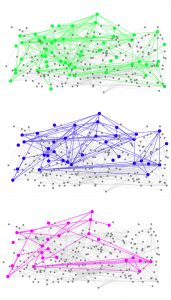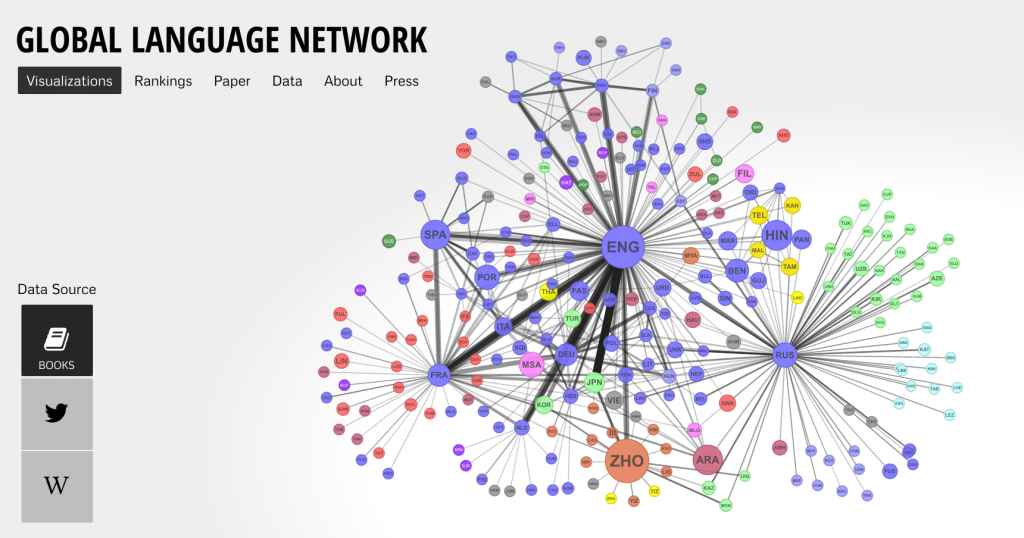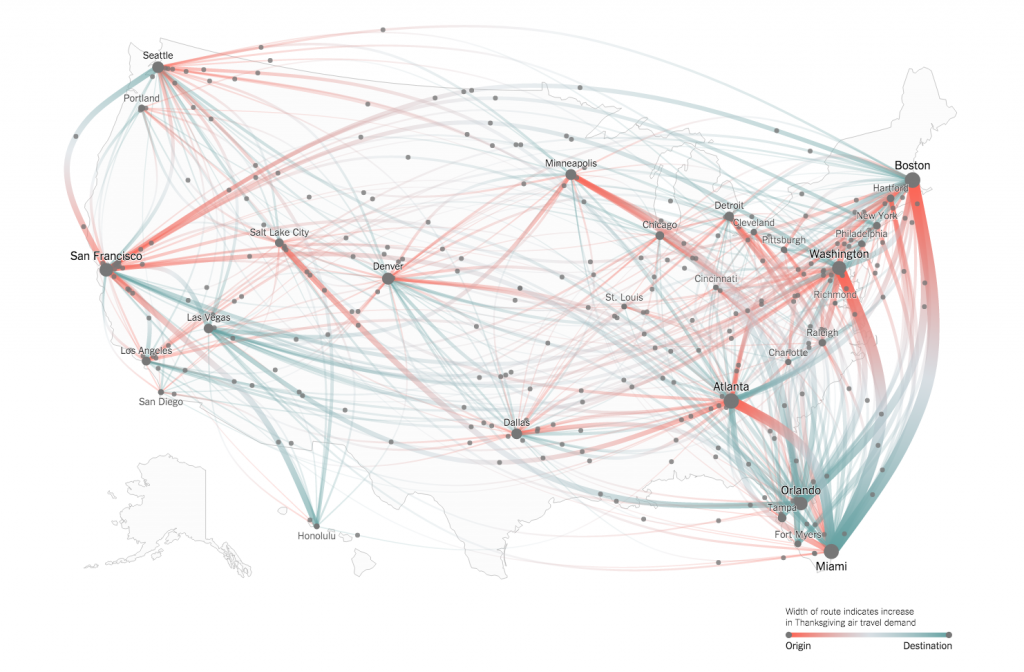
This article published by Indiana University Bloomington describes a new study one of its researchers has published in the journal Neuroscience, drawing a close analogy between airline routes and the neuronal network in our brain.

This article published by Indiana University Bloomington describes a new study one of its researchers has published in the journal Neuroscience, drawing a close analogy between airline routes and the neuronal network in our brain.
 Rodger D. Hodge of the New Republic reports on CEO Tony Hsieh’s recent decision to shift Zappo’s to the Evolutionary Teal style of management through Holacracy. This hotly discussed new approach discards static, hierarchical power structures for more distributed and plastic forms of leadership. As defined by Frederic Laloux in Reinventing Organizations, Evolutionary Teal organizations “trust in the abundance of life” and focus on self-actualization rather than material goals. This means something different to every organization and Zappo’s implementation came with a wave of controversial new policies. The sudden and radical switch was received with mixed reviews from within and without. The jury is still out on whether Hsieh’s move represents a meaningful reform or is simply another flash in the pan of the avant-garde corporate.
Rodger D. Hodge of the New Republic reports on CEO Tony Hsieh’s recent decision to shift Zappo’s to the Evolutionary Teal style of management through Holacracy. This hotly discussed new approach discards static, hierarchical power structures for more distributed and plastic forms of leadership. As defined by Frederic Laloux in Reinventing Organizations, Evolutionary Teal organizations “trust in the abundance of life” and focus on self-actualization rather than material goals. This means something different to every organization and Zappo’s implementation came with a wave of controversial new policies. The sudden and radical switch was received with mixed reviews from within and without. The jury is still out on whether Hsieh’s move represents a meaningful reform or is simply another flash in the pan of the avant-garde corporate.
Read the full article here: https://newrepublic.com/article/122965/can-billion-dollar-corporation-zappos-be-self-organized
 In an article recently published by PNAS, Shahar Ronen et al. “introduce a metric of a language’s global influence based on its position in the network” of co-spoken languages. They show that the “connectivity of a language in this network … remains a strong predictor of a language’s influence”. In other words the more likely a language is to show up on a polyglot’s resume, the more influential it is. The authors provide a super cool user-friendly web-based visualization tool to explore the data!
In an article recently published by PNAS, Shahar Ronen et al. “introduce a metric of a language’s global influence based on its position in the network” of co-spoken languages. They show that the “connectivity of a language in this network … remains a strong predictor of a language’s influence”. In other words the more likely a language is to show up on a polyglot’s resume, the more influential it is. The authors provide a super cool user-friendly web-based visualization tool to explore the data!
Read the full article here: http://www.pnas.org/content/111/52/E5616.abstract
Check out the super cool interactive language mapping tool here: http://language.media.mit.edu/visualizations/books

How was your holiday travel? A recent New York Times article “Pumpkin Pie in Miami” shows flight pattern networks in the US over thanksgiving holiday, using search data from Google Flights revealing the movements of over 3.6 million Americans during the Thanksgiving holiday. The takeaway: Americans fly warm and late. An overwhelming number of travelers chose destinations like Miami or Las Vegas and flight volume peaked at noon on Thanksgiving Day!
Six Degrees of Francis Bacon is a collaboration between Georgetown University and Carnegie Mellon University to map out social networks in the 16th and 17th centuries. After data-mining the entire Oxford Dictionary of National Biography, Professor Daniel Shore of Georgetown and Jessica Otis of CMU were able to digitize the social networks of the period between 1500-1700, and now the project is accepting contributions from the public. Using this newly-launched platform, users can discover that John Milton (Paradise Lost,Paradise Regained), for instance, had connections not just to poets but to composers, musicians, clergy, educators, and even scientists. The Six Degrees of Francis Bacon project is one piece of the growing movement in digital humanities, where humanists use computers and technology to make significant discoveries in literature and history that were impossible before, and allows researchers to make more sophisticated interpretations.
Link to the web article can be found here: http://gizmodo.com/mapping-16th-century-social-networks-with-six-degrees-o-1739236038
A two-year long field study recently provided a large data set consisting of several trail networks built by the Australian meat ant to connect different nests spread over a wide territory.
By studying these networks, researchers at Uppsala University, Fordham University, and the University of Sydney, have found the basic rules that allow ants to build efficient and low cost transport networks that can scale to larger networks.
“Ants are able to find a specific balance between cheapness, efficiency and robustness,” explains Tanya Latty, researcher in biology at the University of Sydney.
Specifically, they found that a simple model of network growth—the minimum linking model (MLM)—is sufficient to explain the growth of real ant colonies. The MLM method describes the rules for how to connect one nest to another. This method links the new nest to its closest nest or tree, as long as the distance between the two is minimal over all the nest–tree distances. Using this method, researchers could reproduce the structure (i.e., the distribution of the number of hubs per colony) of actual ant colonies. The researcher suggested that they could extend these finding to building efficient networks in applied settings. The MLM method produces networks higher values of efficiency and cost compared to similar methods, with only slight increases in cost.
“Once we have found what nature does, we have tried to apply the same simple rules to predict what would happen to man-made system, electric grids for example, if they were built by these ants,’ says Arianna Bottinelli, PhD student at Uppsala University.”
One specific application could be the building a new suburb, which requires connecting the power network of cities in a cheap but efficient way.
Story Links:
http://phys.org/news/2015-10-ants-networks.html
http://rsif.royalsocietypublishing.org/content/12/112/20150780
“One more step along the long road towards brain-to-brain interfaces” (PLOS Neuro blog)
OpenStreetMap is an open-sourced mapping website, which is a website where anyone, anywhere can edit and add infrastructure, stores, traffic jams, and more. These different map layers can be taken off and on by an individual user depending on what they are looking for.
The article is specifically about the website in relation to humanitarian efforts like in Nepal. Mappers and volunteers can go onto OpenStreetMap and and use satellite images as well as previous information collected to identify helicopter landing zones, residential areas, and if the highway network is still intact. With this information, aid workers can the go into the area of crisis and more effectively and efficiently help those in need.
Link to the Full Article: http://opensource.com/life/15/5/nepal-earthquake-hfoss
Letter from Silicon Valley about LinkedIn’s the founder and executive chairman, Reid Hoffman. In 2003, Hoffman and Mark Pincus, the founder and chief executive of the gaming site Zynga, bought the Six Degrees patent, a methodology for constructing social networks. When he started LinkedIn, “the most popular social-networking sites, like Friendster and MySpace, didn’t focus on business; and the most popular employment sites, like Monster.com, didn’t focus on social networks.”
LinkedIn currently has more than three hundred and eighty million members, and it is working on creating “the economic graph, which would track all employment activity in the world, for the 3.3 billion people who work, with LinkedIn as the platform”.
The full article can be found here.
WIRED correspondent Nick Stockton claims that all 10 scientists receiving a 2015 MacArthur Genius Grant have one important unifying trait: network thinking. Thought the MacArthur Foundation claims to have no systematic bias beyond “exceptional creativity”, Stockton argues that, from policy to programming, each recipient’s work demonstrates “how individual parts affect a whole system, or how a network affects its nodes”, claiming “that’s where most of the big work in science is headed. You think some lone genius is going to figure global climate change?…These days, scientists make their discoveries in context, not in isolation.” To read more about this year’s recipients in science and beyond, visit:
https://www.macfound.org/fellows/class/2015/
WIRED Article: http://www.wired.com/2015/09/10-new-macarthur-genius-scientists-connected/